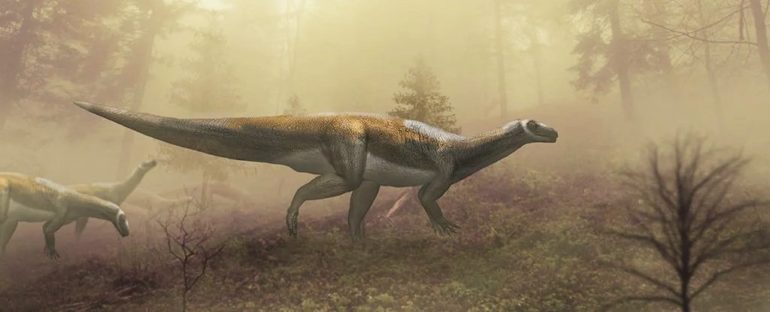Experts have taken another look at 220-million-year-old footprints found in a coal mine in Ipswich, Australia in the 1960s – and concluded that they belong to a timid, long-necked herbivore rather than a bigger, raptor-like carnivore, as was originally thought.
The updated assessment was made possible by a more detailed analysis of the original footprints – including their spacing and orientation – as well as comparisons with footprints from other dinosaur species.
Rather than being a fearsome Triassic predator, the creature would have been a smaller and less aggressive plant eater, the researchers concluded. However, it’s still not clear exactly which species the footprints belong to.
The footprint plaster cast. (Anthony Romilio et al, Historical Biology, 2021)
“For years it’s been believed that these tracks were made by a massive predator that was part of the dinosaur family Eubrontes, with legs over two meters [6.6 feet] tall,” says paleontologist Anthony Romilio, from the University of Queensland in Australia.
“This idea caused a sensation decades ago because no other meat-eating dinosaur in the world approached that size during the Triassic period.”
“But our research shows the tracks were instead made by a dinosaur from the Evazoum family – vegetarian dinosaurs that were smaller, with legs about 1.4 meters [4.6 feet] tall and a body length of 6 meters [19.7 feet].”
Some 200 meters (656 feet underground), the large bird-like footprints would have originally been made on damp layers of plant debris, before being filled in with silt and sand to be preserved for humans to find many millennia later.
That plant material eventually turned into coal that was dug out by miners in the 1960s, revealing the natural casts of dinosaur footprints. The mine itself has long since closed, but plaster casts were made of the findings.
These casts were converted into 3D models, enabling researchers to assess minor details – such as how a foot might have been dragged to extend the size of the footprint, the positioning of the digits and claws, and the overall gait – and rethink the implications of the findings.
“Unfortunately, earlier researchers could not directly access the footprint specimen for their study, instead relying on old drawings and photographs that lacked detail,” says Romilio.
The new study was also able to draw on decades’ worth of additional research that wasn’t available in 1964 of course, analyzing the footprints of Eubrontes and Evazoum dinosaurs discovered all over the world in great detail.
With the help of these comparisons and a more detailed look at the plaster casts that were originally made, experts are much more confident that we’re looking at a friendlier plant-eating dinosaur – though more samples would be required to know which species in particular this is.
Assessing dinosaur characteristics from footprints alone is never easy, and the researchers behind the new study are keen to avoid diminishing the hard work of the paleontologists who came before them.
“This is still a significant discovery even if it isn’t a scary Triassic carnivore,” says paleontologist Hendrik Klein, from the Saurierwelt Paläontologisches Museum in Germany.
“This is the earliest evidence we have for this type of dinosaur in Australia, marking a 50-million-year gap before the first known quadrupedal sauropod fossils.”
The research has been published in Historical Biology.



